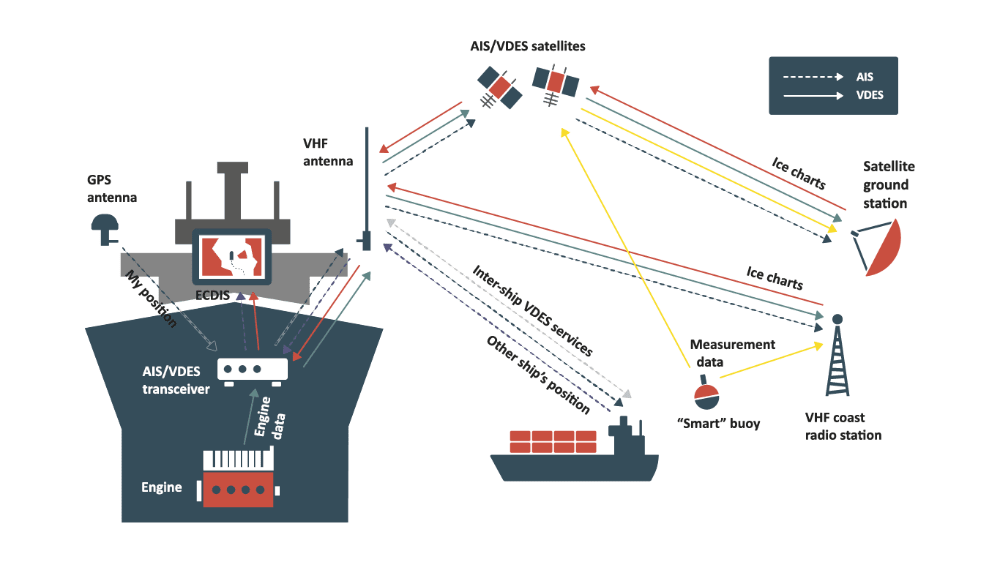
The advent of New Space and small satellites has facilitated access to space for all sectors. The tracking of ships and the communications of the naval sector are one of the areas where the use of CubeSats constellations may have the greatest impact in the near future, especially with the arrival of VDES services (VHF Data Exchange System).
Why is there a need for an evolution in maritime communications? The current Automated Identification System (AIS) was a major breakthrough in the 1990s. This breakthrough came about due to the need to prevent shipping accidents caused by poor communication. The International Maritime Organization (IMO), the United Nations agency responsible for shipping safety and security, made it mandatory for all vessels over 500 tonnes (300 tonnes for international voyages) to install the AIS communication system from 2002 onwards.
Since then, AIS has improved the efficiency of voyages, which explains its current use, but this has not prevented some problems from arising that call for an evolution in the technology needed for ship tracking and maritime traffic safety.
VDES services are the answer to these needs. From the International Telecommunication Union (ITU) and the International Association of Marine Aids to Navigation and Lighthouse Authorities (IALA) the VDES standard has been proposed to mitigate the current problems. This new paradigm is expected to substantially improve ship tracking and maritime satellite communications.
The main benefits of VDES services compared to the current AIS system are its ability to offer two-way communications and the encryption of transmitted information, designed from the outset to operate via satellite (VDE-SAT) and with the possibility of avoiding communication saturation in areas with a high concentration of vessels.

Source: Sternula
Who are the potential users of VDES services, and what are its uses?
In the shipping industry, many users are interested in upgrading and improving maritime communication. In today's maritime traffic, it is estimated that about 47% of vessels sail in waters out of range of AIS transponders, so it is only a matter of time before the system is renewed.
Due to the increasing demand for continuous connectivity on board vessels, VDES services are geared to cover a wide range of use cases, such as the ones detailed below:
- SAR (Search and Rescue) communications for rescue missions.
- Maritime safety communications, g. real-time hydrographic and meteorological information.
- Vessel reporting, with information on course, speed, position, identifier, etc.
- Maritime traffic services, such as port pilotage, traffic organisation, etc.
- Reception of nautical charts and publications of interest to the crews of the vessels.
- Environmental protection, for example, with services related to ocean spills and pollution, response to natural disasters or predictions of melting ice in certain areas, such as the Arctic.
With these practical applications, the implementation of VDES services can be a revolution for the maritime sector, both in governmental and commercial projects with an interest in providing solutions to different types of users:
- Port authorities and shipping companies. Like AIS, VDES services allow the monitoring of any type of vessel. It should not be forgotten that maritime traffic is one of the main means of transporting goods and, in this sense, the VDES system allows for more accurate vessel monitoring and tracking.
- Coast Guard and Coastal Police. When rescuing vessels or people, it is vital to know their exact location and last connection. The field of safety is one of the most important in the maritime sector, as rescue operations can be extremely difficult without the right information.
- Insurance companies. Reducing and controlling the risks associated with maritime traffic can give insurers more room to avoid potential claims worth millions.
- Scientific missions to protect the environment. The use of buoys connected to the VDES network, for example, can measure pollution levels and inform the science mission of changes over time.
What is the SHIPMATE VDES communications project?
At commercial level, VDES ship tracking communications will start to be deployed in the coming years thanks to the major advances in terms of access to space offered by small satellite constellations.
Several projects are already underway to respond to this transformation of communications in the maritime sector. One of the most promising initiatives currently underway is SHIPMATE (Satellite Hybrid Information Protocol for Maritime Telecommunications) which is the result of a consortium between three partners with extensive experience in the field of communications: Egatel, Alén Space and Gradiant.
SHIPMATE's main objective is the design and development of a network based on VDES and 5G, allowing two-way communication between vessels, buoys, virtual beacons, and shore stations, providing a complete solution to monitor everything that happens in the maritime environment. Communication will be carried out via the terrestrial and satellite components of the VDES standard and with the 5G network, through the mMTC and eMBB service categories.
The maritime communications revolution is getting closer and closer. The design and implementation of VDES services for ship tracking will be a paradigm shift from the current AIS system, providing a major improvement in terms of cost-effectiveness, sustainability, and safety.
If you need expert advice to set up a project in the maritime sector offering VDES or AIS services via satellite, please contact our team.








Stay in Touch